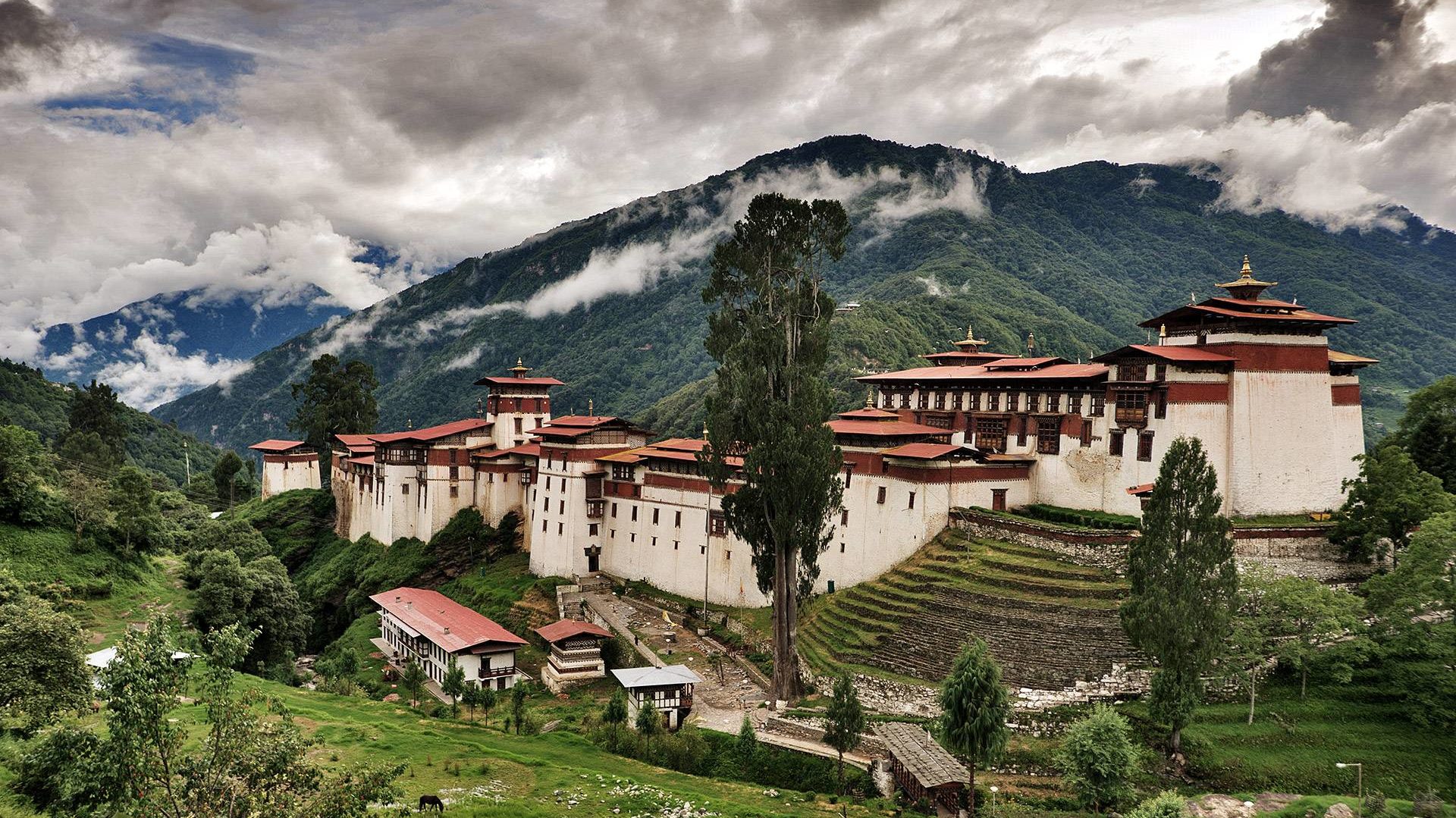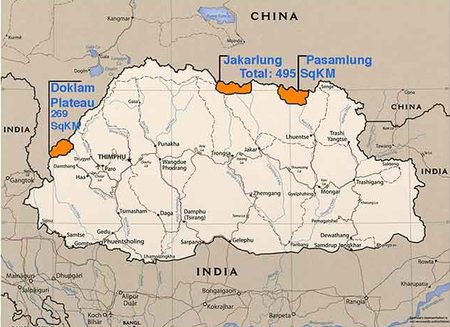

Areas of disputed border between Bhutan and China
Bhutan shares a 470 km border with China, 25% of which remains disputed. Historically, relations between India and Bhutan were governed be the Friendship Treaty signed in 1949, which prevented India from interfering in the internal administration of Bhutan and provided for Bhutan to be guided by India’s advice regarding its external relations. In the context of China’s occupation of Tibet, Jawaharlal Nehru declared in 1959 that any aggression against Bhutan would be regarded as an aggression against India. Since then, the border between Bhutan and China remains undelineated. Although in 1960, Zhou Enlai said that China has no claim on Bhutan, other Chinese leaders have since made assertions such as Bhutanese, Sikkimese and Ladakhis have always been subject to Tibet and to the Chinese motherland, and that “They must once again be united and taught the communist doctrine.”
Bhutan has safeguarded India’s security interests and, unlike Nepal, cooperated with India to exploit hydro-power assets. However, India has taken Bhutanese allegiance for granted. The 1962 war and India’s annexation of Sikkim created insecurity, prompting Bhutan to in 1971 to request a seat at the UN. Bhutan later opened diplomatic relations with Bangladesh and agreed to develop hydro-power, as well as initiate free trade through Bangladeshi ports, as well as cooperating in water resources management.
Tensions started to lessen with China in 1988 after the signing of the first bilateral agreement between China and Bhutan on border peace. Bhutan’s formal diplomatic channels with China have proceeded via an Honorary Consul in Macau since 2000 and Hong Kong since 2004.
In 2005, Bhutan claimed that Chinese soldiers were building roads and bridges within Bhutanese territory to further its territorial claims. China asked Bhutan to cede 269 km2 in the west including Dramana, Shakhatoe and Sinchulung in return for 495 km2 of Pasamlung and Jakarlung in the north, as well as the Doklam Plateau located on the strategic tri-junction of Bhutan, Chumbi Valley and Sikkim. China has been upgrading infrastructure in nearby areas. In 2007, Bhutan’s interim administration produced a map without its tallest peak Kulakangri, “cartographically ceding” the area to China. During 2008-2013, Bhutan neither accepted the swap nor tried to regain the land. China has already seized over 8,000 km2 since 2010. In June 2013 PLA troops intruded through the Sektang region in the east and Pang La region in the north, building three posts inside Bhutanese territory.
In 2007, Bhutan’s first democratically elected government shifted Bhutan’s India-centric foreign policy. The India-Bhutanese Treaty of 2007 stipulates that the respective governments cooperate closely on issues relating to their national interests, with neither allowing the use of its territory for activities harmful to the national security and interest of the other. Thimphu diversified its international contacts, maintaining informal contact via their embassies in New Delhi and via the UN with France, the U.S. and the U.K. Diplomatic relations with China are maintained through Bhutan’s New Delhi Embassy. In 2012, PRC Premier Wen Jiabao and the former Bhutanese PM Jigme Thinley had their first meeting in Rio, Brazil. New Delhi accused Thimphu of keeping India in the dark on matters impinging common security. This was followed in 2013 by a crisis in which India withdrew all subsidies on cooking gas and kerosene being provided to Bhutan, straining bilateral ties.
Chinese media was quick to criticise India’s "coercive and brazen interference" in Bhutan’s election, claiming India was treating Bhutan as a colony to meet its own strategic needs. In 2013, Chinese Vice Foreign Minister Liu Zhenmin visited Thimphu to discuss broadening relations. With the Chinese plans to extend the Lhasa railway to Shigatse and then to Yadong adjacent to Chumbi Valley, another track connecting to Nyingchi near Arunachal Pradesh, and the additional highways to Lhasa from Golmud and Kunming already under construction, it is here that Bhutan provides a useful window for China to widen linkages with South Asian countries. Any restoration of Bhutan’s pivotal role as a trading nation could therefore enhance China’s manoeuvrability and a means of better aligning with the SAARC members. As already achieved in Nepal, China is trying to win access to profit-making opportunities for its companies in areas such as tourism, hydroelectricity, infrastructure building, and mining.
As with Nepal, China does not want Bhutan to become a launch pad for Tibetan freedom fighters, although for years now Bhutan’s has supported the ‘One China Policy’.
India and Bhutan’s economic ties are unbalanced, with Bhutan’s exports (95 per cent) and imports (75 per cent) of goods to and from India reflecting the degree of dependency. Even India’s investment in hydro-power squeezed the space for domestic stakeholders, creating “jobless growth” for Bhutan. Detrimental aspects include illegal cross border trade, under-invoicing, tax evasions, illegal bank transaction and unfair, exploitative, monopolistic commercial practices by Indian contractors – especially in the mining and construction sectors, and continual accretion of public debt, ultimately benefiting India. Decades of subsidy have led to the neglect of Bhutan’s own agriculture sector. As such, the prospect of reviving its role as a trading hot spot role has become enticing for Bhutan and, and Bhutanese political parties have started to incline towards China, to India’s distress.
Shortly after Narendra Modi’s first official visit to Bhutan as Indian PM in July 2014, border talks took place between China’s State Councillor Yang Jiechi and Bhutanese Foreign Minister Rinzin Dorje in Beijing.
The Doklam Plateau is a sparsely populated 269 km2 area in the North West part of Haa District, western Bhutan, located at the Bhutan-Tibet-India tri-junction. China has staked claim to the area, which has been the target of increasing Chinese military incursions.
Since its early days until the late 1990s, the PRC had refused to recognise Bhutan as a sovereign country, regarding it as one of the “five fingers of Tibet” together with Ladakh, Nepal, Sikkim and Arunachal Pradesh. In 1988, the PLA crossed into Bhutan and took control of the Chumbi valley, near Doklam. In 1998, China and Bhutan signed a peace agreement to “maintain peace and tranquillity” on their border areas, amounting to a reversal of China’s earlier policy. Two years earlier, in an effort to resolve a long-standing border dispute, China had offered to renounce its claim over an area of disputed land in the Pasamlung and Jakarlung valleys at Bhutan’s northern border totalling 495 km2 in exchange for the Doklam Plateau.
The Chinese have employed familiar encroachment tactics using Tibetan graziers to establish territorial claims. After decades of border talks China offered to trade 900 km2 of territory in the north for 400 km2 in the west encompassing Doklam, Sinchula and Draman in the Chumbi valley. Geo-strategically, Doklam is a key vantage point, a piece of dominating ground with a commanding view of the dagger-shaped Chumbi Valley, which points perilously towards India's “Chicken’s Neck”, the Siliguri corridor in North Bengal, which connects its restive north east to the rest of the country. Doklam lies immediately east of Indian defences in Sikkim. A Chinese occupation of Doklam could turn the flank of Indian defences completely and ultimately prevent India’s land access and supply routes to 40 million citizens in its north east territories. This is detailed in our analysis of the geopolitics of Sikkim.
While India has no territorial claim on Doklam and having ceded its right to guide Bhutan’s foreign policy in 2007, India still has an implicit obligation to defend Bhutan’s territorial integrity, underscored by the Indian Army’s presence in Bhutan.
The nightmare of Indian defence circles caused by China's presence in Bhutan near the Chumbi Valley became a waking reality in 2017. For 73 days Chinese and Indian forces faced off following an attempt by PLA engineers to construct a road through Doklam. In coordination with Bhutanese authorities, Indian soldiers based just across the border halted the Chinese crews. Ominously, during the standoff - which coincided with the peak flood season - China refused to transmit data to India on cross-border flows of the Brahmaputra River. After weeks of tense negotiations, Delhi and Beijing withdrew their forces to their original positions. While China was initially said to have “blinked” because it abandoned the project, since then more troops have been deployed and new all-weather infrastructure built up in the area, steadily gaining territorial advantage.
As well as gaining military advantage over India, this classical Chinese "salami-slicing" approach by China to build up its road network will eventually allow China to hand a "fait accompli" to Bhutan in its territorial dispute, negating years of border talks. Chinese presence in Doklam also places pressure on Bhutan to establish more formal diplomatic relations with China. Bhutan is more closely aligned with India and at times allows the Indian military to operate in Bhutan. As the Chinese develop their infrastructure and presence in Tibet and south west China, China will likely increase its pressure on Bhutan to be more receptive to Chinese regional engagement.
At present no formal diplomatic channels are established between China and Bhutan. China has instead relied on its religious soft power to penetrate the country and create the conditions for a favourable shift in its inhabitants’ perception of China. Informal envoys in the form of Han Buddhist monks accredited by Beijing have gifted Bhutan an enormous religious statue, constructed in a region close to Bhutan’s northern border with China. With great fanfare these Han monks have been welcomed on Bhutanese soil and received at the highest levels of Bhutanese society, taking full advantage of this channel of influence.
Relations Between Bhutan and Neighbouring Countries, Centre for Bhutan Studies (2004)
Obama’s “Asia Pivot”: The Himalayan Angle, Strategic Culture Foundation (2013-08-01)
India and Bhutan: Strategic Imperative Institute for Defence Studies and Analyses (2014-09)
Understanding India-Bhutan relations, One India (2014-06-18)
Bhutan: The Indian Army’s Front Line, Diplomat (2014-11-06)
What Were China's Objectives in the Doklam Dispute?, RAND Corporation (2017-09-08)